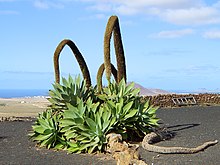
Back Leeustert Afrikaans أجاف أتنيواتا Arabic اجاف اتنيواتا ARZ Драконово дърво агаве Bulgarian সিংহলেজা Bengali/Bangla Agave attenuata Catalan Agave attenuata CEB Drachenbaum-Agave German Agave attenuata Spanish Tähkäagaave Finnish
| Agave attenuata | |
|---|---|

| |

| |
| A. attenuata x A. shawii 'Blue Flame' | |
| Scientific classification | |
| Kingdom: | Plantae |
| Clade: | Tracheophytes |
| Clade: | Angiosperms |
| Clade: | Monocots |
| Order: | Asparagales |
| Family: | Asparagaceae |
| Subfamily: | Agavoideae |
| Genus: | Agave |
| Species: | A. attenuata
|
| Binomial name | |
| Agave attenuata Salm-Dyck 1834
| |
| Synonyms[2] | |
| |
Agave attenuata, commonly called the foxtail or lion's tail agave or the swan's neck agave, is a species of flowering plant in the family Asparagaceae (the asparaguses, agaves and yuccas). Sometimes called the soft-leaf or soft-leaved agave, the aforementioned animal-related names are a nod to the appearance of the plant's inflorescence, which—after years, generally—rises slightly before gravity brings it back down, giving the bloom a curved, "swan"-like or "foxtail" look. The species' specific manner of flowering is unique in the genus Agave as most other species produce a towering, vertical display, reminiscent of a miniature tree.[3]
In addition to its inflorescence, when compared with other Agave species, A. attenuata is further unique with its soft, spineless leaves and the fact that it does not rapidly asexually produce dozens of "runners" or "pups" from the rhizome of the mother plant. These factors have helped A. attenuata earn a positive reputation amongst gardeners as easy-to-manage; the species has become extremely popular as an ornamental plant in appropriate climates and zones, especially the American Southwest, Latin America and the Mediterranean.[4]
Several unique forms and cultivars have been created and made available on the plant market, such as the white-variegated A. attenuata 'Variegata' and 'Ray of Light', or the teal-hued 'Boutin Blue'. The similarly teal-leaved 'Blue Flame' was achieved with the cross of Agave attenuata x Agave shawii.[5]
- ^ García-Mendoza, A.J.; Sandoval-Gutiérrez, D.; Torres-García, I.; Linares, J. (2019). "Agave attenuata". IUCN Red List of Threatened Species. 2019: e.T114936958A114963376. doi:10.2305/IUCN.UK.2019-3.RLTS.T114936958A114963376.en. Retrieved 20 November 2021.
- ^ The Plant List, Agave attenuata
- ^ Robert Zander : Zander hand dictionary of plant names. Edited by Fritz Encke , Günther Buchheim, Siegmund Seybold .15th edition, corrected reprint of the 14th edition. Eugen Ulmer, Stuttgart 1994, ISBN 3-8001-5072-7
- ^ "Agave attenuata".
- ^ "Agave Blue Flame — GDNC Nursery".
The hybrid was created in LA, California. Its parents, Agave shawii[,] is native to Southern California and Mexico's Baja California, which include[s] both desert and temperate coastal climate[s], and Agave attenuata[;] is native to central Mexico, which has warm and humid summers.
© MMXXIII Rich X Search. We shall prevail. All rights reserved. Rich X Search
